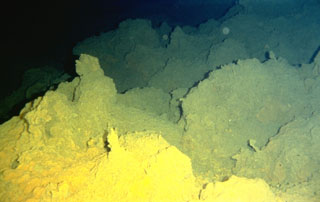Report on Kama'ehuakanaloa (United States) — 13 July-19 July 2022
Smithsonian Institution / US Geological Survey
Weekly Volcanic Activity Report, 13 July-19 July 2022
Managing Editor: Sally Sennert.
Please cite this report as:
Global Volcanism Program, 2022. Report on Kama'ehuakanaloa (United States) (Sennert, S, ed.). Weekly Volcanic Activity Report, 13 July-19 July 2022. Smithsonian Institution and US Geological Survey.
Kama'ehuakanaloa
United States
18.92°N, 155.27°W; summit elev. -975 m
All times are local (unless otherwise noted)
An earthquake swarm began at Kama'ehuakanaloa at about 0200 on 16 July and was characterized by seismic tremor accompanied by pulses of seismic energy every 15-20 seconds. The pattern of elevated seismicity continued through at least 1453 on 17 July, the posting time of the HVO’s information statement. The report also noted that around 24 earthquakes in the M 1.8-3 range were recorded during 0130-0600 on 17 July. The Scientist-in-Charge stated that the seismicity was likely the result of magma movement beneath the seamount, but there were no show signs of an imminent eruption. The most recent swarm was recorded on 11 May 2020 and consisted of 18 events in the M 3-3.9 range. The Volcano Alert Level and the Aviation Color Code both remained at Unassigned; there are no working monitoring instruments on the volcano so information is based on and-based seismometers.
Geological Summary. The Kama’ehuakanaloa seamount, previously known as Loihi, lies about 35 km off the SE coast of the island of Hawaii. This youngest volcano of the Hawaiian chain has an elongated morphology dominated by two curving rift zones extending north and south of the summit. The summit region contains a caldera about 3 x 4 km and exhibits numerous lava cones, the highest of which is about 975 m below the ocean surface. The summit platform also includes two well-defined pit craters, sediment-free glassy lava, and low-temperature hydrothermal venting. An arcuate chain of small cones on the western edge of the summit extends north and south of the pit craters and merges into the crests prominent rift zones. Seismicity indicates a magmatic system distinct from that of Kilauea. During 1996 a new pit crater formed at the summit, and lava flows were erupted. Continued volcanism is expected to eventually build a new island; time estimates for the summit to reach the ocean surface range from roughly 10,000 to 100,000 years.
Source: US Geological Survey Hawaiian Volcano Observatory (HVO)

